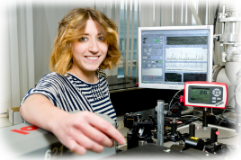Setups - Laboratory for Astrophysics - Leiden Observatory
Main menu:
- Harold Linnartz
- Scientific Record
- Laboratory for Astrophysics
- Ice Database
- Teaching
Setups
Laboratory for Astrophysics

CRYOPAD2 (CRYOgenic Photoproduct Analysis Device) is an ultra-high vacuum setup fully optimized to study the effects of UV irradiation on inter- and circumstellar ice analogues. A special microwave discharge lamp is used to simulate the radiation fields in space. Ices are grown with monolayer precision for temperatures as low as 15 K. Reflection absorption infrared spectroscopy (RAIRS) and temperature programmed desorption (TPD) are used to quantify the photodesorption, photodissociation and photoprocessing of ice samples upon UV irradiation.
In collaboration with Prof. Fillion and Dr. Bertin (UPMC), we have been working on wavelength dependent VUV studies using the DESIRS beamline at the synchrotron facility SOLEIL.
SURFRESIDE2 (SURFace REactions SImulation DEvice) is an UHV setup that has several similarities with CRYOPAD. RAIRS and TPD are used as analytical tools to monitor reactions in the interstellar ice analogues, but chemical reactions are triggered upon non-energetic processing by impacting H/D-, N- or O-atoms or OH/OD radicals that are generated in two special atom beam lines. The experimental details are available from Ioppolo et al. RSI 84 (2013) 072112.


MATRI2CES (Mass Analyzing Tool for Reactions in Interstellar ICES) combines laser desorption and TOF detection. The aim of the setup is to detect mass spectrometrically reaction products in an ice upon UV irradiation and/or H-atom bombardment. The ultimate goal is to repeat the famous 'Yellow stuff Greenberg experiments' but in situ and in real time. Ultimately, the setup will answer the question whether the building blocks of life can grow in the ice layers on dust grains in space. Details of the setup are available from Paardekooper et al. RSI 85 (2014) 104501.
OASIS (Optical Absorption Setup for Ice Spectroscopy) is one of the few setups to study chemical processes in interstellar ice analogues using optical spectroscopy. The light of a broadband lamp is guided through an ice substrate onto a spectrometer where the light is dispersed. The technique allows to record electronic spectra and to monitor chemical reactions, in situ and essentially in real time. The method is not affected by water absorptions in the ice and as transition strengths are higher, OASIS allows to study low density ices. In the last years the focus has been on PAH containing water ice, as PAH are thought to be omnipresent in space. More recently, amino acids are studied as part of the PEPSci network, to investigate whether such important molecules would survive conditions as encoutered when transfering complex molecules to (exo)planets. Very recently, the setup has been used to determine the wavelength dependent refraction index of interstellar ice analogues, using a new type of broadband interference spectroscopy.

SPIRAS (Supersonic Plasma InfraRed Absorption Spectrometer) is used to record high resolution infrared spectra of molecular transients of astrophysical interest. The setup comprises a planar plasma setup in which rotationally cold ions, radicals and ionic complexes are formed that are studied in direct absorption using an Nd:YAG pumped OPO laser system and applying cw-CRDS as detection technique. Details are available from D. Zhao et al. Chem. Phys. Lett. 565 (2013) 132.
BB-DIB is a recently constructed broad band cavity enhanced spectrometer spectrometer that focuses on the identification of optical absorption features as observed through interstellar clouds. A supersonic planar plasma source is used to simulate interstellar cloud conditions and os-BBCEAS or CESAS, two new techniques developed in the Sackler Laboratory, are used to record signals in direct absorption. See for details A. Walsh et al. J. Phys. Chem. A, 117 (2013) 132.

The HV SETUP is used to systematically measure solid state spectra of interstellar ice analogues in full dependence of mixing ratio and ice temperature. A Varian 670 FTIR setup makes it possible to measure spectra and to analyze data instantaneously. The outcome is used to compare with astronomical spectra, from ISO, Spitzer and soon to come the JWST. We also used this setup to determine the thermal behavior of porosity in interstellar ices. This is important as the level of porosity determines the amount of accessible surface area. The HV setup is a setup that is often used for student projects. In 2019 a fully upgraded system will be implemented, also capable of determining absorption band strengths.
i-POP (Instrument for Photodynamics of PAHs) is a fully mobile instrument, comprising ion-trap TOF technology to study the fragmentation behavior of large PAHs upon photo-processing. Recent results show that large PAHs can transfer into fullerenes, offering a new complementary chemical pathway to form new species in space (see Zhen et al. ApJ 797 (2014) L30. The setup is fully mobile and has been used at DESIRS-SOLEIL and FELIX. This project is performed in close collaboration with Prof. Tielens.
